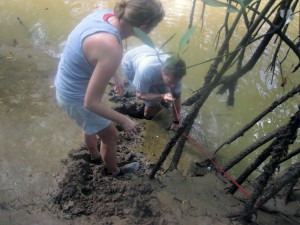by Katrina Lohan
First of all, our stuff arrived! After a few more phone calls to the customs office, everything went smoothly and all of our gear was delivered on Tuesday—not too shabby, really!

STRI biologist Mark Torchin attempts to climb a stream bank after obtaining oysters from the mangrove roots. (Katrina Lohan)
At this site, we decided to check out the mangroves first to see if there were any oysters attached to their roots that we could sample. While we found some, they were pretty difficult to get off. Our collaborator, Mark Torchin, thought it safest to strap himself to a mangrove, as the banks were made of soft mud and it is all too easy to fall into the stream. Additional acrobatics, such as scaling mangroves, navigating through root mazes, and climbing back up off the muddy banks, were required to get these oysters, but we prevailed and were able to walk away with about 30 individual oysters.
We then headed back out to scrape oysters off the rocks and found two different species, Saccostrea palmula and a species of Crassostrea, in the rocky intertidal zone. As our supplies had arrived, I now had the equipment necessary to obtain and filter water samples as well, so I walked out along the rocks to get a liter of surface water from the incoming tide. Part of my fellowship research involves comparing the different kinds of parasites in the water column to what is infecting and being filtered by the oysters. Water sampling is just one way of obtaining a more complete picture of parasite diversity in the different sites that we are sampling.

